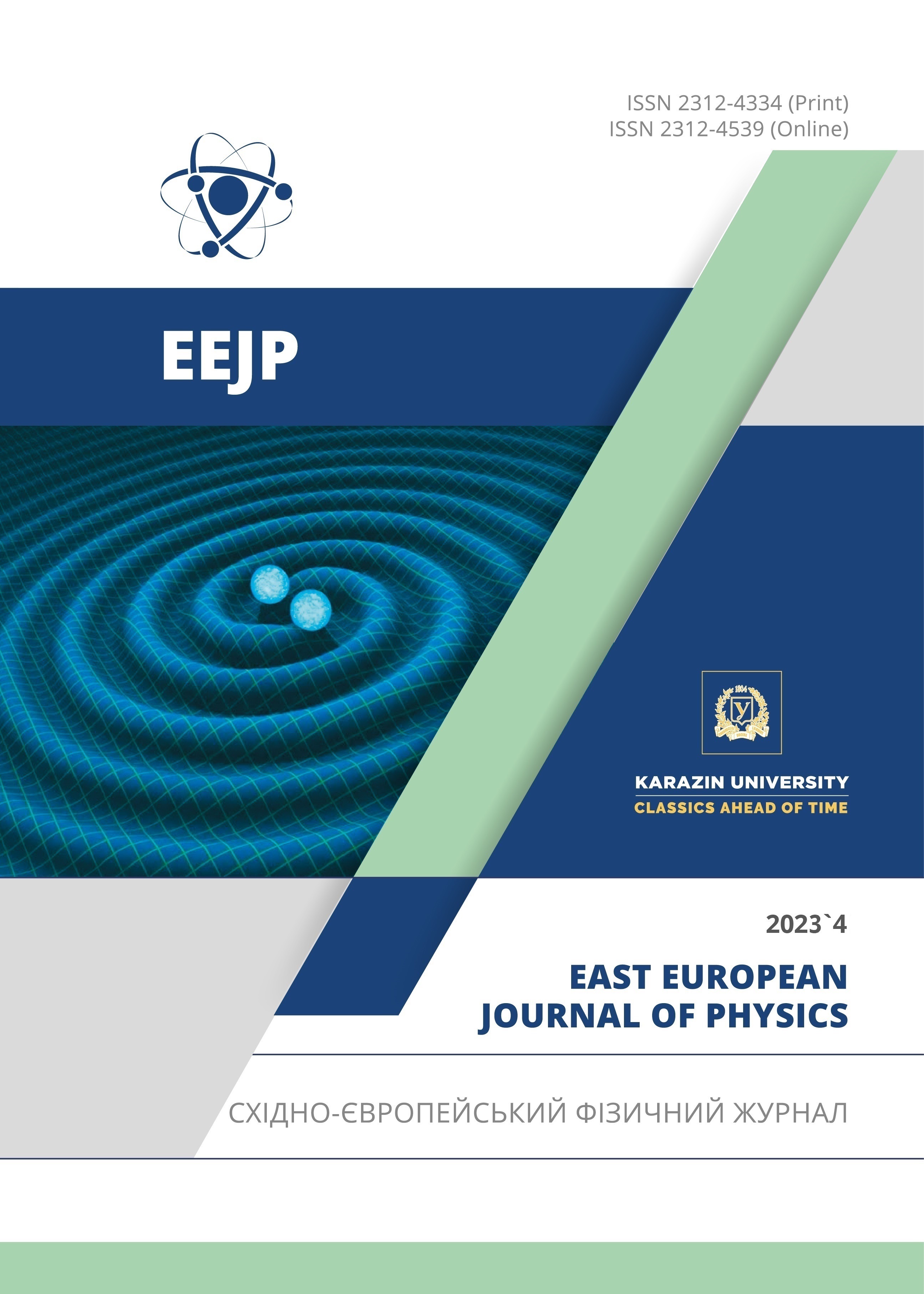Synthesis of Pure and Manganese Doped Zinc Oxide Nanoparticles by a Solution Growth Technique: Structural and Optical Investigation
Abstract
Pure and manganese doped zinc oxide nanoparticles have been successfully synthesized over the composition range, Zn1-xMnxO (0<x<0.5), by a solution growth process. The effect of Mn doping on the structure, morphology and optical properties were investigated by several techniques. X-Ray diffraction studies confirmed the formation of a single-phase polycrystalline hexagonal wurtzite structure of ZnO within the range, 0 < x < 0.3. No Mn related secondary phases were detected, within this range, which could be attributed to the fact that the dopant atoms had been well incorporated into the ZnO crystal lattice. For Zn1-xMnxO (x = 0.5), several low intensity peaks belonging to remnants of Manganese acetate were observed in the diffractogram, establishing a solubility limit for the synthesis technique used. The variation of d-spacing with Mn percent doping showed a very good agreement with Vergard’s law within the range (0<x<0.25). EDAX analysis of the nanoparticles was consistent with the formation of Mn doped ZnO. The optical band gap of the ZnO nanoparticles decreased linearly with increasing Mn percent doping, suggesting the possibility of tuning the band gap of ZnO by doping with Mn.
Downloads
References
P. Chaudhary, F. Fatima, and A. Kumar, Journal of inorganic and organometallic polymers and materials, 30, 5180 (2020). https://doi.org/10.1007/s10904-020-01674-8
R.N. Ali, H. Naz, J. Li, X. Zhu, P. Liu, and B. Xiang, Journal of Alloys and Compounds, 744, 90 (2018). https://doi.org/10.1016/j.jallcom.2018.02.072
F. Giovannelli, A.N. Ndimba, P. Diaz-Chao, M. Motelica-Heino, P.I. Raynal, C. Autret, and F. Delorme, Powder Technology, 262, 203 (2014). https://doi.org/10.1016/j.powtec.2014.04.065
M. Gotić, T. Jurkin, S. Musić, K. Unfried, U. Sydlik, and A. Bauer-Šegvić, Journal of Molecular Structure, 1044, 248 (2013). https://doi.org/10.1016/j.molstruc.2012.09.083
G. Voicu, O. Oprea, B. S. Vasile, and E. Andronescu, Journal of Nanomaterials and Biostructures, 8(2), 667 (2013). https://chalcogen.ro/667_Voicu.pdf
R. Buonsanti, and D.J. Milliron, Chemistry of Materials, 25(8), 1305 (2013). https://doi.org/10.1021/cm304104m
A.K. Singh, G.S. Thool, P.R. Bangal, S.S. Madhavendra, and S.P. Singh, Industrial & Engineering Chemistry Research, 53(22), 9383 (2014). https://doi.org/10.1021/ie500077v
N. Singh, S. Mittal, K.N. Sood, and P.K. Gupta, Chalcogenide Letters, 7(4), 275 (2010). http://chalcogen.ro/275_Singh.pdf
D. Wu, Z. Huang, G. Yin, Y. Yao, X. Liao, D. Han, X. Huang, and J. Gu, Cryst. Eng. Comm. 12(1), 192 (2010). https://doi.org/10.1039/B909780E
A.S. Hassan, K. Abdalla, and A.M. Moanes, IJSRSET, 3(8), 94 (2017). https://ijsrset.com/paper/3167.pdf
T.M. Dhruvashi, and P.K. Shishodia, Adv. Mater. Lett., 7(2), 116 (2016). https://doi.org/10.5185/amlett.2016.5966
A. Boumezoued, K. Guergouri, M. Zaabat, D. Recham, and R. Barille, in: Proceeedings of International Agricultural, Biological & Life Science Conference, edited by Y. Kaya, and T. Popova, (Edirne, Turkey, 2018), 250-258.
E.N.A. Armah, F.K. Ampong, M. Egblewogbe, H.A. Koffi, F. Boakye, J.K.A. Amuzu, and R.K. Nkum, Advanced Nano Research, 2(1), 53 (2019). https://doi.org/10.21467/anr.2.1.53-61
T.J. Jacobsson, Naturvetarprogrammet Kemi, (Uppsala Universitet, 2009).
E.N.A.A. Armah, M. Egblewogbe, H.A. Koffi, A.A. Yankson, F.K. Ampong, F. Boakye, J.K.A. Amuzu, and R.K. Nkum, Adv. Nan. Res. 3(1), 28 (2020). https://doi.org/10.21467/anr.3.1.28-39
N. Guermat, W. Daranfed, I. Bouchama, and N. Bouarissa, Journal of Molecular Structure, 1225, 129134 (2021). https://doi.org/10.1016/j.molstruc.2020.129134
M. Shatnawi, A.M. Alsmadi, I. Bsoul, B. Salameh, M. Mathai, G. Alnawashi, G.M. Alzoubi, et al., Results in Physics, 6, 1064(2016). https://doi.org/10.1016/j.rinp.2016.11.041
P. Sebayang, C. Kurniawan, R.Y. Lubis, I. Priyadi, and D. Aryanto, Makara Journal of Science, 24(2), 5 (2020). https://doi.org/10.7454/mss.v24i1.11914
A.K. Singh, G.S. Thool, P.R. Bangal, S.S. Madhavendra, and S.P. Singh, Industrial & Engineering Chemistry Research, 53(22), 9383 (2014). https://doi.org/10.1021/ie500077v
R. Saravanan, F. Santhanam, and J.L. Berchmans, Chemical Papers, 66(3), 226 (2012). https://doi.org/10.2478/s11696-011-0129-8
D.S. Cook, J.E. Hooper, D.M. Dawson, J.M. Fisher, D. Thompsett, S.E. Ashbrook, and R.I. Walton, Inorganic Chemistry, 59(6), 3805 (2020). https://doi.org/10.1021/acs.inorgchem.9b03459
U. Hotjie, C. Rose, and M. Binnewies, Solid State Sciences, 5(9), 1259 (2003). https://doi.org/10.1016/S1293-2558(03)00177-8
F.K. Ampong, J.A.M. Awudza, R.K. Nkum, F. Boakye, P.J. Thomas, and P. O’Brien, Solid State Sciences, 40, 50 (2015). https://doi.org/10.1016/j.solidstatesciences.2014.12.013
B. Clavier, A. Zhadan, T. Baptiste, F. Boucher, A. Guiet, F. Porcher, V. Brezová, et al., Dalton Transactions, 51(21), 8411 (2022). https://doi.org/10.1039/D2DT00352J
G.M. Muralikrishna, B. Tas, N. Esakkiraja, V.A. Esin, K.H. Kumar, I.S. Golovin, I.V. Belova, et al., Acta Materialia, 203, 116446 (2021). https://doi.org/10.1016/j.actamat.2020.10.065
E.A. Botchway, F.K. Ampong, I. Nkrumah, D.B. Puzer, R.K. Nkum, and F. Boakye, East European Journal of Physics, 2, 249 (2023). https://doi.org/10.26565/2312-4334-2023-2-28
M. Paal, I. Nkrumah, F.K. Ampong, D.U. Ngbiche, R.K. Nkum, and F. Boakye, Science Journal of University of Zakho, 8(3), 97 (2020). https://doi.org/10.25271/sjuoz.2020.8.3.752
D. Thakur, A. Sharma, A. Awasthi, D.S. Rana, D. Singh, S. Pandey, and S. Thakur, Chemosensors, 8(4), 120 (2020). https://doi.org/10.3390/chemosensors8040120
I. Nkrumah, F.K. Ampong, A. Britwum, M. Paal, B. Kwakye-Awuah, R.K. Nkum, and F. Boakye, Chalcogenide Letters, 20(3), 205 (2023). https://doi.org/10.15251/CL.2023.203.205
A. Abdel-Galil, M.R. Balboul, and A. Sharaf, Physica B, 477, 20 (2015). https://doi.org/10.1016/j.physb.2015.08.001
Copyright (c) 2023 Raymond A. Antwi, Isaak Nkrumah, Francis K. Ampong, Mark Paal, Reuben Y. Tamakloe, Reuben K. Nkum, Francis Boakye

This work is licensed under a Creative Commons Attribution 4.0 International License.
Authors who publish with this journal agree to the following terms:
- Authors retain copyright and grant the journal right of first publication with the work simultaneously licensed under a Creative Commons Attribution License that allows others to share the work with an acknowledgment of the work's authorship and initial publication in this journal.
- Authors are able to enter into separate, additional contractual arrangements for the non-exclusive distribution of the journal's published version of the work (e.g., post it to an institutional repository or publish it in a book), with an acknowledgment of its initial publication in this journal.
- Authors are permitted and encouraged to post their work online (e.g., in institutional repositories or on their website) prior to and during the submission process, as it can lead to productive exchanges, as well as earlier and greater citation of published work (See The Effect of Open Access).








